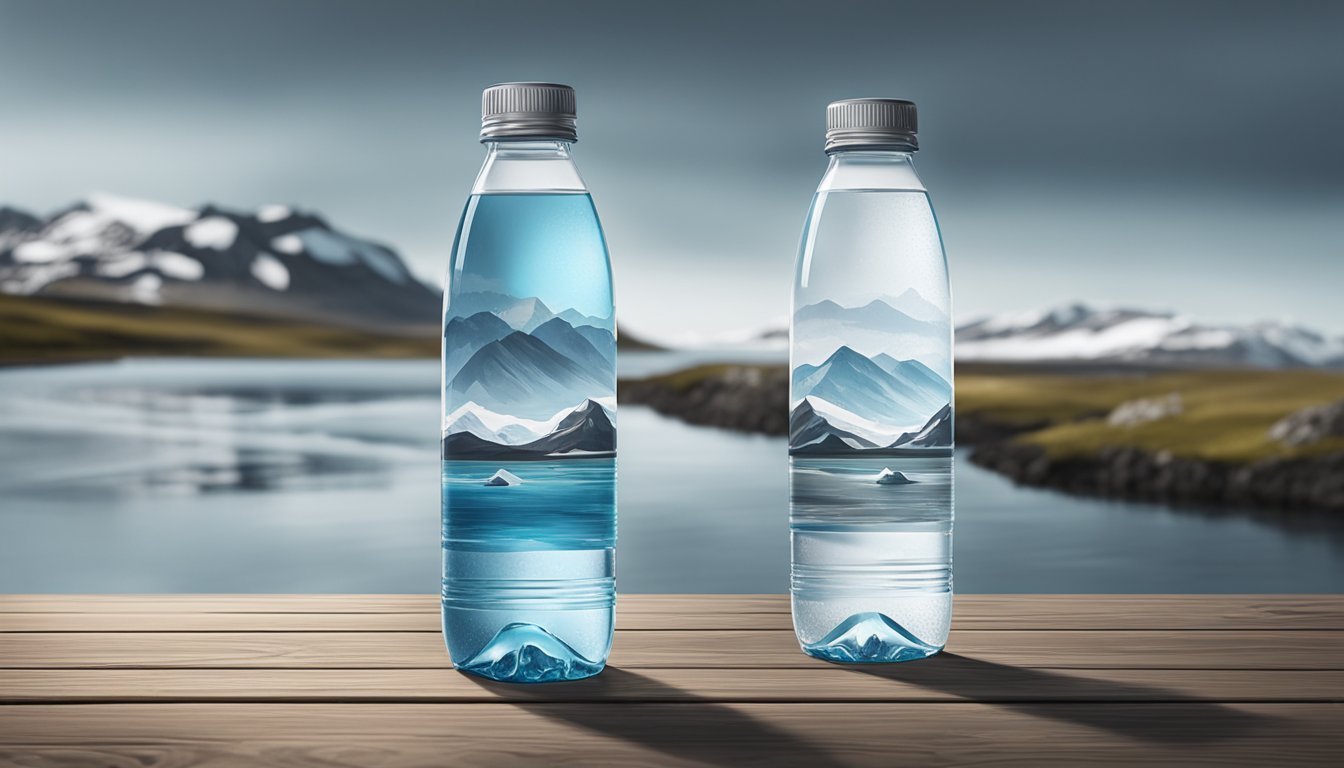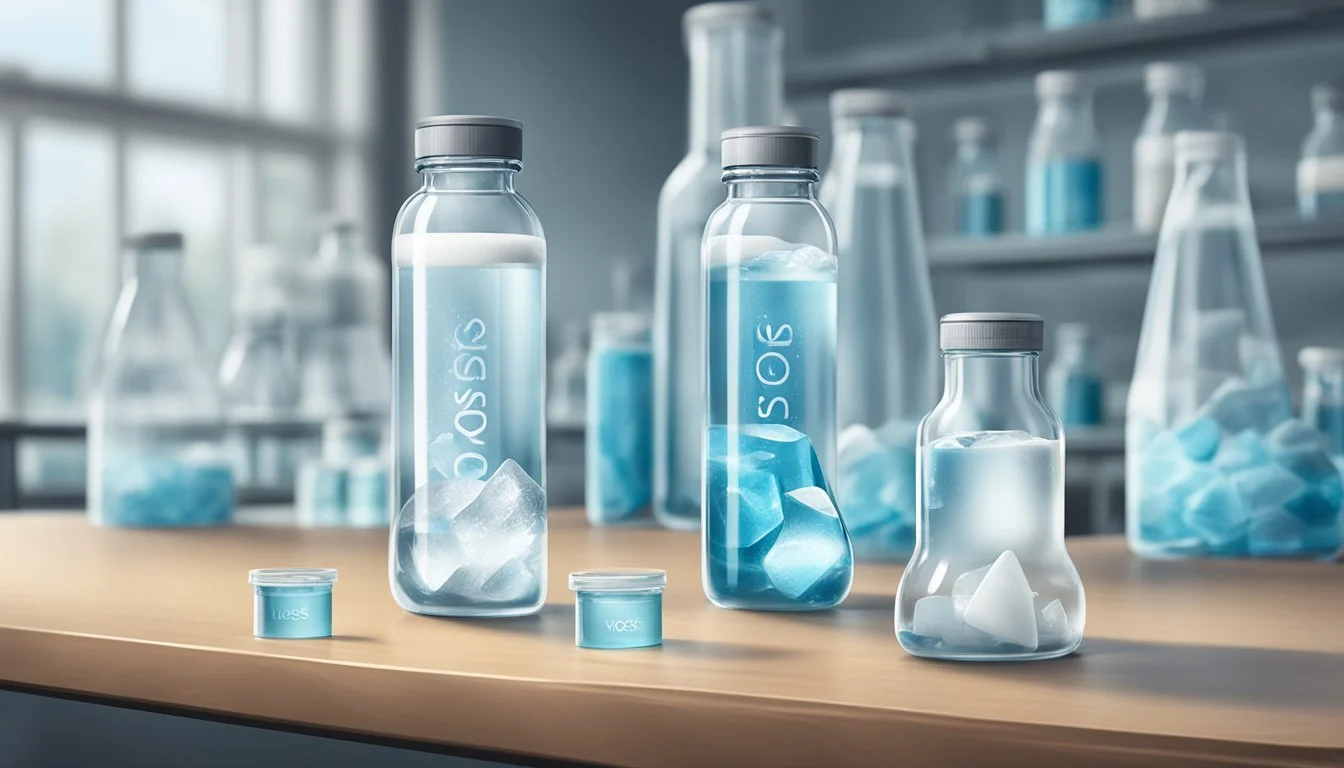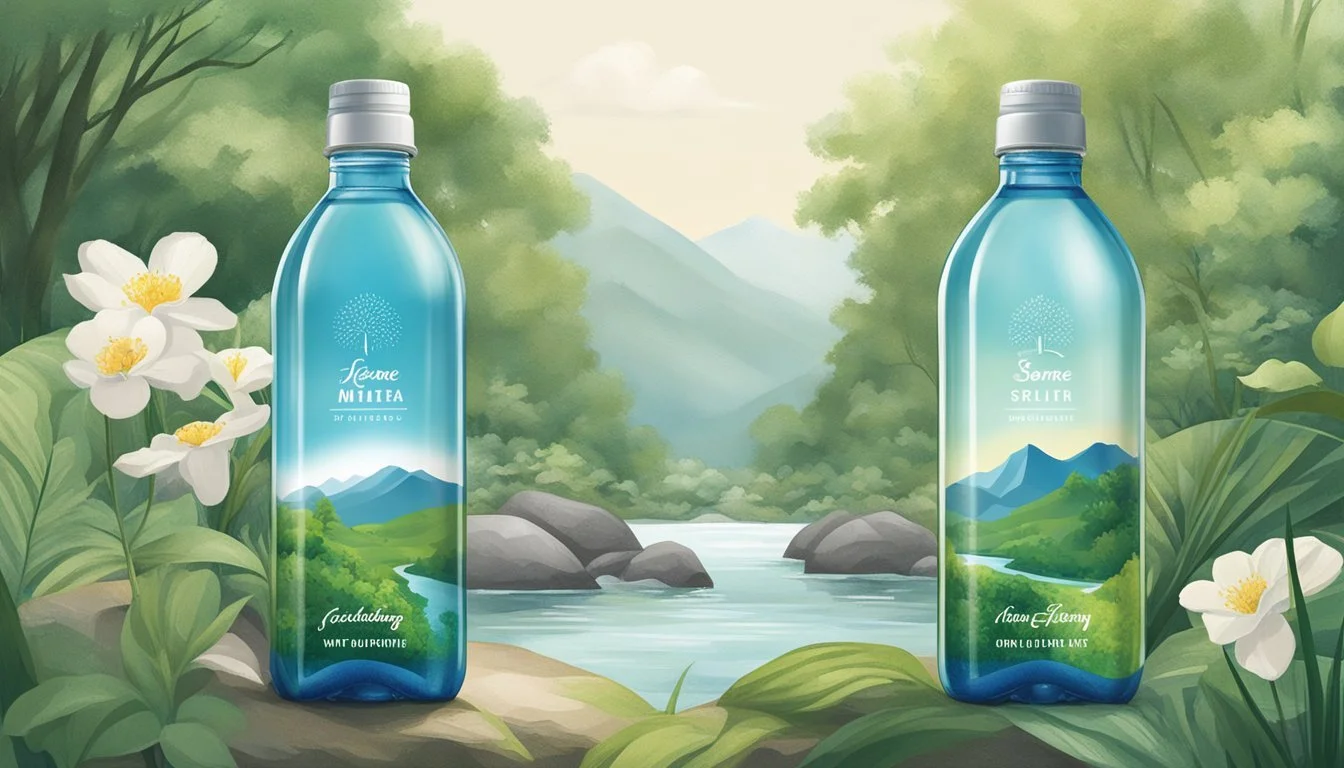Icelandic Glacial vs. Voss
Comparing Quality and Taste of Bottled Waters
When it comes to bottled water, the choices can be overwhelming, but among the plethora of options, Icelandic Glacial and Voss stand out due to their unique sources and branding. Bottled water enthusiasts often debate which brand offers the superior hydration experience. Both brands have carved out prestigious places in the market, with Icelandic Glacial boasting its origin from the Olfusa spring in Iceland, known for its purity and sustainable production practices. Voss, on the other hand, is sourced from an artesian well in southern Norway, with a reputation for its low mineral content and stylish packaging.
Choosing between Icelandic Glacial and Voss is not just a matter of taste but also involves considering various factors like sustainability practices, mineral content, and the environmental impact of the bottling process. Consumers look to these premium brands not only for their water needs but also for the values they represent. The water from Iceland is naturally filtered and boasts a high pH level, while Voss is often noted for its crisp taste and designer bottle, making it a common sight in luxury hotels and restaurants.
The comparison between Icelandic Glacial and Voss may indeed come down to individual preference, as both waters have loyal followers. However, a thorough analysis and side-by-side comparison can provide clarity on which brand may be more preferable in terms of quality, taste, and commitment to environmental stewardship. Each brand's unique attributes contribute to their standings in the fiercely competitive bottled water market.
Understanding Bottled Water
When it comes to bottled water, consumers often consider the type of water, its source, potential health benefits, and the reputation of the brands they're choosing.
Types of Bottled Water
Spring Water: Spring water is collected from a natural spring and may contain minerals that naturally enhance its flavor and provide electrolytes.
Mineral Water: This type of water is defined by its constant level and relative proportions of minerals and trace elements at the point of emergence from the source. No minerals may be added to this water.
Alkaline Water: Alkaline water has a higher pH level than regular drinking water and some brands, like Icelandic Glacial, naturally have a high alkaline pH due to their water source.
Water Source and Origin
Each bottled water company sources its water from specific locations:
Icelandic Glacial: Originates from the Olfusa spring in Iceland, boasting purity due to filtration through volcanic rock over thousands of years.
Voss: Sourced from an artesian source in southern Norway and is known for its low mineral content.
Both brands bottle their water at the source to preserve quality and reduce contamination.
Health and Hydration Benefits
Water is essential for hydration, and some brands offer added benefits:
Electrolytes: Natural waters, like spring and mineral types, can contain electrolytes, which are vital for body functions.
Alkaline Water: With high pH levels, alkaline water from brands like Icelandic Glacial can contribute to neutralizing the acid in a consumer's bloodstream.
The mineral content in bottled waters, such as calcium, magnesium, and potassium, contribute to the nutritional value and health benefits of staying hydrated.
Bottled Water Companies and Brands
When evaluating companies:
Transparency: They typically offer information about the source and purification processes of their water.
Sustainability: Brands like Icelandic Glacial emphasize sustainability through carbon offsetting, while others prioritize eco-friendly packaging.
Consumers often rely on brand reputation and product reviews, like the thousands of Amazon reviews available for Icelandic Glacial, to gauge quality and make informed choices.
Comparing Icelandic Glacial and Voss
In the realm of premium bottled water, Icelandic Glacial and Voss are renowned for their distinctive sources and quality. This section delves into their origins, mineral content, packaging, and their standings in consumer markets.
Origin and Water Source
Icelandic Glacial water emerges from the Ölfus Spring in Iceland, filtered naturally through layers of volcanic rock which imbue it with a balanced mineral content. In contrast, Voss water hails from the pristine aquifers in Southern Norway, often associated with the untouched wilderness of the Norwegian terrain.
Mineral Content and Taste
The mineral content of water greatly influences its taste:
Icelandic Glacial:
Silica: ~10 mg/L
Sodium: Low
Potassium: Trace amounts
Voss:
Silica: Not specified
Sodium: Low
Potassium: Not specified
Consumers report Icelandic Glacial as crisp and clean, with a low mineral content that does not overwhelm the palate. Meanwhile, Voss is also praised for its purity and a taste that is smooth and refreshing.
Packaging and Environmental Impact
Icelandic Glacial and Voss both offer packaging solutions that reflect their brand images of luxury and commitment to sustainability:
Icelandic Glacial: Bottles are made from fully recyclable materials and the company prides itself on being certified CarbonNeutral®.
Voss: Available in high-quality glass bottles that are widely recyclable, with some product lines also offering recyclable PET options.
Both companies face scrutiny regarding the environmental impact of bottled water and strive to reduce their carbon footprints through various initiatives.
Market Presence and Consumer Perception
In terms of market presence, both brands enjoy a global reach:
Icelandic Glacial: Boasts over 10,000 reviews on major online platforms like Amazon, signaling a strong and loyal consumer base.
Voss: Mimics this global presence and is recognized for its iconic cylindrical glass bottle, contributing to its premium image.
Consumer perception of both brands is generally positive, with each brand garnering a reputation for high-quality, good-tasting water that offers a luxurious hydration experience.
Analyzing Water Quality and Purity
In assessing the quality and purity of Icelandic Glacial and Voss bottled waters, this section will compare Total Dissolved Solids (TDS) and pH levels, evaluate the presence of contaminants, and review certifications and standards concerned with drinking water safety.
TDS and pH Balance
Icelandic Glacial water reports a TDS level around 62 parts per million (ppm), indicating a low mineral content. Its pH level is typically listed as 8.4, categorizing it as a naturally alkaline water.
Voss, known for its purity and fresh taste, has a TDS level approximately 44 ppm, also reflecting low mineral content. The pH level hovers close to neutral at 6-7, providing a different balance than Icelandic Glacial.
Presence of Contaminants
Icelandic Glacial boasts that their water is virtually free from common contaminants like fluoride, chloride, and heavy metals, positioning it as one of the purest waters available.
Voss, sourced in Norway, adheres to strict quality control processes that keep contaminants such as fluoride, chloride, magnesium, and calcium at minimal levels, ensuring the water's purity and safety for consumption.
Certifications and Standards
Both Icelandic Glacial and Voss meet the necessary certifications and standards that affirm their commitment to quality.
Icelandic Glacial is certified CarbonNeutral® for both product and operation. It meets stringent international standards, including NSF International and the Icelandic Food and Veterinary Authority.
Voss is also subject to rigorous safety and quality control measures, complying with standards enforced by the Norwegian Food Safety Authority and other international bodies.
Each company's adherence to these certifications indicates a significant investment in maintaining the purity and quality of their bottled water, making both contenders for the title of best bottled water in terms of quality and safety.
Exploring Additional Water Brands
In examining other market offerings, this section provides insights into the most popular bottled water brands and their unique selling propositions.
Comparison of Popular Brands
Fiji: Drawn from an aquifer in Fiji, this water is noted for its soft taste and high silica content.
Evian: Sourced from the French Alps, Evian is recognized for its mineral-rich composition and balanced pH.
Poland Spring: Originating from Maine, USA, Poland Spring is known for its refreshing taste and natural filtration process.
Deer Park: From springs in the eastern United States, Deer Park boasts of a fresh and pure taste.
Acqua Panna: Hailing from Italy, this water's smooth taste and terroir are emblematic of the Tuscan hills from where it is sourced.
Essentia: Essentia's ionized alkaline water is distinguished by its unique ionization process, offering a higher pH which the brand claims supports better hydration.
Ice Mountain: Sourced from the heart of the Midwest, it offers naturally occurring minerals and a clean taste.
Smartwater: Vapor-distilled for purity, Smartwater includes added electrolytes for taste.
Mountain Valley Spring: Flowing from the Ouachita Mountains, this water has a unique mineral composition and a heritage dating back to 1871.
Eternal Water: It boasts naturally occurring electrolytes from its source in the Shasta-Trinity Alps.
Special Features and Selling Points
Each brand emphasizes unique features that set it apart:
Core Hydration: Optimized to match the body’s natural pH.
Penta: Ultra-purified and infused with oxygen for a distinct taste.
San Pellegrino: Notable for its fine bubbles and presence of natural minerals, offering a unique taste favored by many in fine dining.
Gerolsteiner: Originates in Germany and is celebrated for its high calcium and magnesium levels.
LIFEWTR: Purified and pH-balanced, with distinct artistic packaging meant to inspire.
Perrier: A French brand famous for its naturally carbonated spring water.
Crystal Geyser: Utilizes a natural alpine spring source and is known for its commitment to eco-friendly packaging.
Most brands innovate to cater to distinct consumer preferences, from enhanced pH levels and added mineral content to eco-conscious packaging and filtration processes. This differentiation ensures a diverse range of options for consumers in the bottled water market.
Sustainability and Environmental Considerations
When examining the environmental impact of Icelandic Glacial and Voss water brands, factors such as sustainable bottling practices and efforts to minimize carbon footprints take center stage. The use of recycled materials and the efficiency of recycling programs also play a significant role.
Bottling Process and Carbon Footprint
Icelandic Glacial boasts a bottling process that occurs right at the source of their natural spring water, the Ölfus Spring in Iceland. They claim that their operation is completely sustainable and maintain carbon neutrality. Icelandic Glacial's Ölfus Spring is replenished by high levels of precipitation and has a production rate that exceeds the total amount of water bottled and exported. This suggests a minimal impact on the local water table.
Voss, sourced in Norway, also takes measures to protect the environment where their water is sourced. Their commitment is evident in their choice to use high-quality bottles, although they do not specifically market themselves as carbon-neutral. However, the impact of transporting their products from Norway to international markets should be considered when assessing their overall carbon footprint.
Recycling and Use of RPET
Icelandic Glacial makes significant strides in their use of packaging materials. Their bottles and cardboard packaging are 100% recyclable. In addition, they offer bottles made from BPA-free high-grade rPET — a material made from recycled plastic bottles — which stands as a testament to their efforts in reducing waste.
Voss has also introduced recycling programs and encourages consumers to recycle their bottles. Recently Voss has been focusing on increasing their use of recycled materials, including rPET, in their bottles. They offer both high-quality PET bottles for their still water and green glass bottles for sparkling water, promoting a premium product while considering sustainability.
Both companies' use of rPET in their bottles is a step towards reducing the environmental burden of plastic waste, aligning with global efforts to enhance the sustainability of bottled water.
Consumer Insights
When examining Icelandic Glacial and Voss bottled waters, consumer insights reveal distinct preferences based on factors such as taste, environmental impact, and brand reputation.
Purchasing Decisions
Consumers tend to make purchasing decisions on bottled water based on a variety of factors. Convenience is a significant aspect; availability at local retailers can influence which brand they buy. Hydration needs are also key, with consumers looking for water that provides efficient hydration as well as a refreshing sensation. Moreover, a smooth mouthfeel and the absence of aftertaste are qualities that consumers often seek out and can sway their choice between Icelandic Glacial and Voss.
Availability: Icelandic Glacial and Voss water are both widely available, but their presence in certain markets can vary, impacting consumer convenience.
Taste and Mouthfeel: Consumers report a preference for a water brand that offers a clean, crisp taste and a smooth mouthfeel, without any heavy mineral flavor.
Consumer Reviews and Preferences
When it comes to consumer reviews and preferences, the reputation of the brand and the perceived quality of the water play prominent roles. Icelandic Glacial's commitment to sustainability and its carbon insetting program are often positively highlighted in consumer feedback.
Icelandic Glacial: Reviews frequently commend its purity and eco-friendly approach.
Voss: Receives acclaim for its low mineral content and premium branding.
Additionally, personal preferences can be influenced by the packaging design—Voss, for example, is noted for its distinctive cylindrical bottle. Both brands have their loyalists, with online reviews mentioning:
Brand Loyalty: Consumers often display loyalty based on their prior positive experiences with the brand, such as satisfaction with the product's consistency in taste and quality.
Environmental Concerns: For some consumers, the brand’s environmental policies are as important as the product itself, impacting their repeat purchase behavior.
Conclusion
When assessing the merits of Icelandic Glacial versus Voss bottled water, several factors come into play. Both brands have carved out distinctive reputations within the bottled water market, often featured on lists delineating the best from the worst.
Icelandic Glacial boasts a source of legendary purity. It originates from the Olfusa spring in Iceland and is lauded for its natural purity and sustainable production practices. Its commitment to environmental responsibility is demonstrated through its carbon insetting program and use of recycled materials for packaging.
On the other hand, Voss has its own share of accolades. Sourced from an artesian source in southern Norway, Voss's water is recognized for its low mineral content, lending to its crisp taste profile. The brand is synonymous with luxury and often associated with high-end dining experiences.
Quality and Taste:
Icelandic Glacial: Naturally pure, not altered to affect pH levels.
Voss: Low mineral content, pure taste.
Environmental Sustainability:
Icelandic Glacial: rPET bottles, carbon insetting program.
Voss: No specific programs highlighted.
Brand Perception:
Icelandic Glacial: Positioned as state-of-the-art, with high consumer loyalty.
Voss: Marketed as a premium product, with an emphasis on design and lifestyle.
In conclusion, choosing the "better" water depends largely on the consumer's priorities. If one highly values environmental sustainability and naturally sourced purity, Icelandic Glacial may hold the edge. For those who prefer a luxurious brand with a distinct taste and low mineral content, Voss could be the preferred choice. Both waters provide a high-quality option for hydration, ultimately leaving the decision to personal preference and values.







